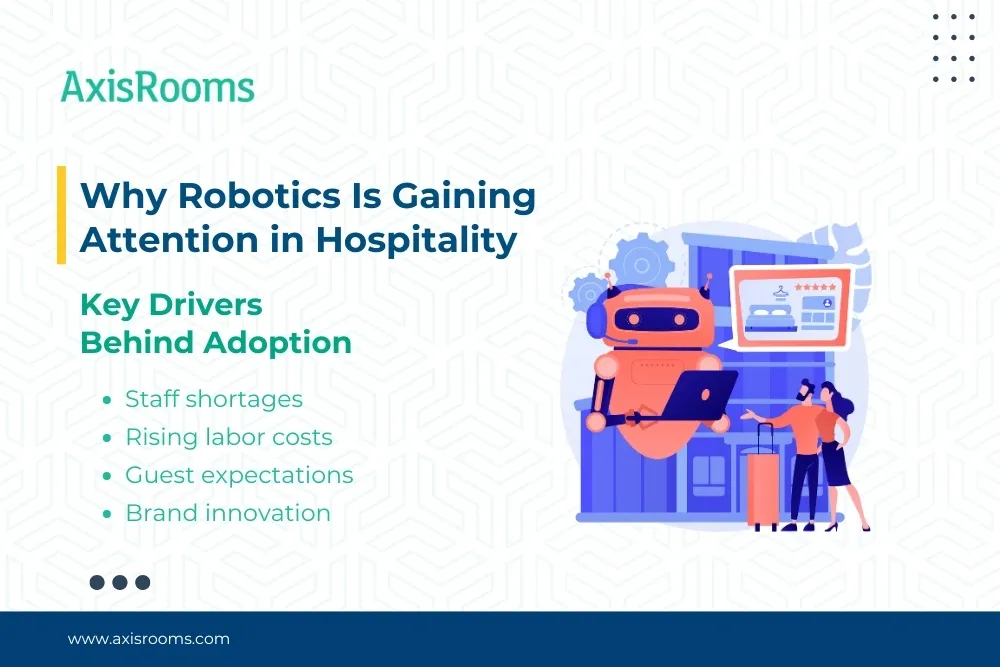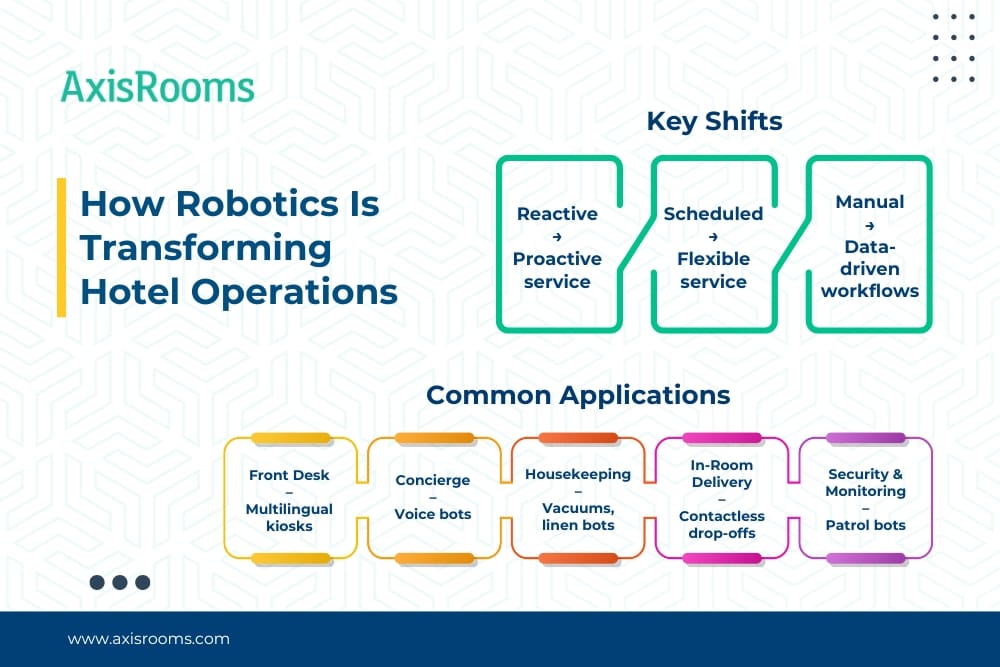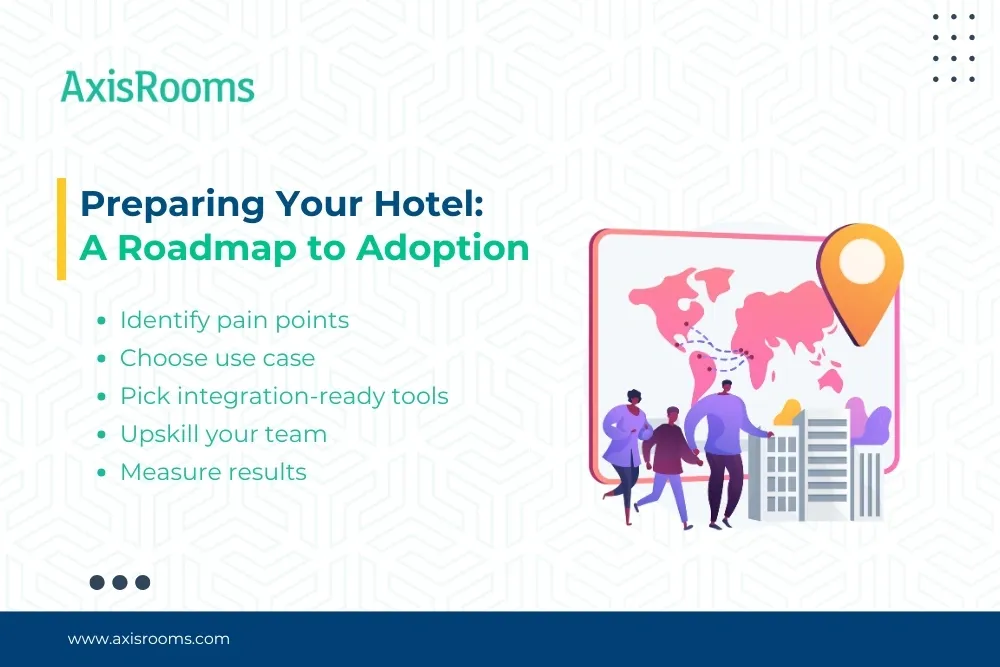Labor shortages. Rising costs. Guest expectations are evolving faster than ever.
As hospitality professionals grapple with these shifts, one technology is steadily emerging—not as a gimmick, but as a game-changing operational tool: robotics.
From robotic room service to AI-enabled housekeeping, hotels are beginning to explore how this technology could improve efficiency, streamline labor, and create memorable guest experiences. But with adoption still in its early stages, what does robotics really mean for the hospitality industry?
This guide walks hoteliers through:
- The role of robotics in the future of hotels
- Real-world case studies and success metrics
- Common challenges and how to overcome them
- A step-by-step roadmap for adoption
- A balanced view of cost vs. long-term value
Why Robotics Is Gaining Attention in Hospitality

As operational costs rise and skilled staff grow harder to retain, hoteliers are rethinking service delivery. Robotics offers a solution that blends automation with intelligent software—addressing both efficiency and consistency.
Key Drivers Behind Adoption:
Real-World Pilots: What’s Working So Far?
Though full-scale implementation is rare, several hotels have piloted robotics with promising results.
Success Stories:
- Henn-na Hotel, Japan First robot-staffed hotel. Introduced robotic check-in kiosks and room porters. Achieved up to 40% reduction in labor costs and 30–40% faster check-ins.
- Hilton’s “Connie” Concierge, USA IBM Watson-powered robot deployed at Hilton McLean. Answered FAQs and reduced front desk congestion by 50%, freeing up human staff for high-value service.
- Savioke Relay Delivery RobotsHotels using Relay report 30% faster service times and 8–12% increases in guest satisfaction scores.
- Aloft Hotels’ “Botlr” Piloted in California; guests received in-room deliveries via robot. Led to increased social media engagement and word-of-mouth buzz, boosting brand awareness.
How Robotics Is Transforming Hotel Operations

Robotics changes not just task handling—but the hotel’s operating model.
Key Shifts:
- Reactive to proactive service: Robots can be programmed to respond to predictable guest patterns.
- Scheduled to flexible service: They run 24/7—no overtime, no shift conflicts.
- Manual to data-driven workflows: Automation tools provide live metrics on completion rates, guest requests, and usage trends.
Common Applications:
Enhancing Guest Experience with Robotics
Despite concerns, robotic tools can actually enhance the guest experience by:
- Reducing wait times: Room service is delivered in 3–5 minutes instead of 15.
- Improving accessibility: Robots can assist guests with mobility needs.language
- Supporting international guests: Multilingual bots remove barriers.
- Creating shareable moments: Guests often post their robot interactions on social media, indirectly improving hotel visibility
In short, robots handle the routine—freeing up staff to focus on personal touchpoints.
Cost & ROI Insights
Robotics isn't cheap—but the long-term value can be compelling.
- Typical robot price: USD 40,000–100,000 (task-dependent) PROVEN Robotics
- Integration & support: +25–50% of base price in year one
- ROI cases:
- Servi robot saved ~USD 60,000 in labor over 3 years
- Matradee saved ~USD 64,500
- Market following studies:
- Robot vacuums delivered measurable ROI via efficiency metrics
- Customer satisfaction bump (+8–12%) often drives ancillary revenue gains
Challenges Hoteliers Must Navigate
Robotics is not a plug-and-play solution. It requires preparation and system alignment.
Preparing Your Hotel: A Roadmap to Adoption

Thinking of testing robotics? Here’s a five-step blueprint:
Seamless Tech Integration: Why AxisRooms Is Built for the Future
AxisRooms PMS acts as a digital command center—routing guest requests, room readiness updates, and service alerts directly to both staff and robots. When connected with service bots, this enables:
- Real-time syncing of robotic housekeeping or delivery updates
- Live room status updates post-cleaning
- Instant guest request fulfillment routed via the PMS
- Smooth OTA integrations and channel inventory syncs after room turnover
This not only streamlines automation but also supports efficient revenue management strategies for independent hotels, ensuring that robotic workflows don't disrupt bookings, inventory accuracy, or guest satisfaction.
In short: Robots need instructions—AxisRooms gives them the data and direction they need to deliver.
What the Future Holds
Robotic innovation is just beginning. Hoteliers can expect:
- Voice-enabled concierge bots personalized by PMS data
- AI-driven housekeeping robots triggered by check-out patterns
- IoT-integrated guest rooms where robots control lighting and temperature
- Inventory bots that restock minibar items automatically
Those who begin piloting now will be ahead of the curve by the time mass adoption arrives.
Final Thoughts: Is Robotics Worth the Investment?
Robotics isn’t about replacing hospitality—it’s about delivering it more efficiently.
If your property struggles with labor costs, inconsistent service, or slow response times, robotics offers a scalable solution. With tools like AxisRooms that support PMS integrations and real-time automation, you're not just investing in tech—you’re setting up your hotel to thrive in a competitive, experience-driven future.
Frequently Asked Questions (FAQ)
Q1. Will robots replace my hotel staff?
A-Robots are here to support your staff, not replace them. They handle routine tasks like deliveries or cleaning, so your team can focus on guest satisfaction and personal service.
Q2. Is it expensive to start using robotics?
A-Robots do require an initial investment, but many hotels begin with one or two. Over time, they help reduce labor costs, improve efficiency, and increase guest satisfaction—giving you long-term value.
3. How do robots connect with my hotel systems?
A-With tools like AxisRooms PMS and OTA integrations, robots can automatically receive and update room status, guest requests, and service information—all in real time.
Ready to explore robotics for your hotel?Let AxisRooms help you plan a smart pilot, align systems, and measure the ROI of your first automation step.Contact us today to learn more.


